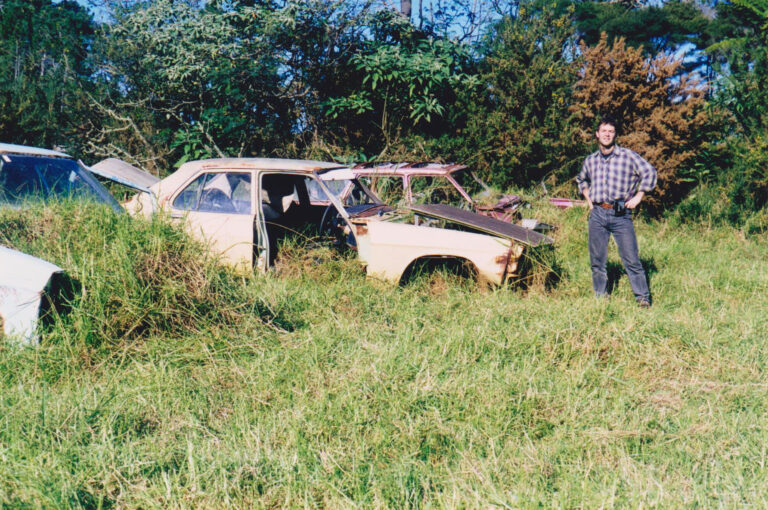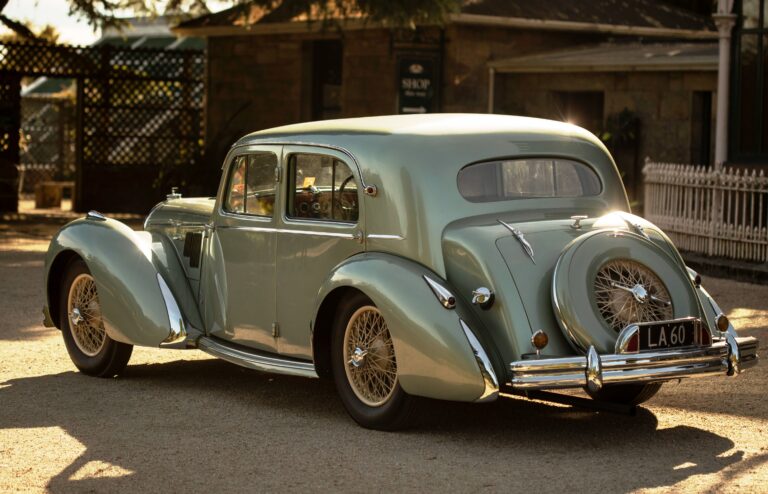
The E-Type’s continuing popularity is perhaps not at all that surprising given this one vehicle seems to top the majority of opinion polls listing the world’s most beautiful cars. And despite the bucketloads of clichés applied at the time of the E-Type’s famous launch at Geneva in 1961 (and ever since) about redefining the way in which we all viewed sports cars, this car really did rewrite the rulebook.
But it wasn’t just the looks of the coupé and roadsters alone that caused a sensation when it was first unveiled — the E-Type also possessed power, extreme engineering and racing pedigree combined with quality, and perhaps most importantly, affordability at a time when rival sports cars from makers such as Ferrari, Porsche and Aston Martin carried much higher price tags. Inevitably, on its initial release demand for the new British sports car skyrocketed — with film and pop stars of the day lining up to place their orders.
Today, over five decades later, the E-Type still has an almost siren-like power to lure and captivate motoring enthusiasts.

Automotive passion
Chris Wilson was certainly not immune to the Jaguar’s fatal attraction, despite growing up on a farm in Central Hawkes Bay. Chris’ father was a true blue-blooded Ford man and, as such, changed his vehicles on a regular basis. They included everything from Falcon utes and saloons to more luxuriously-appointed Fairmonts and Fairlanes.
Chris’ father also had one other automotive passion — Jaguars. The two Mk2s and the S-Type he owned undoubtedly provided the impetus for Chris’ appreciation of these quality-built British cars. As well as these big cats, his father owned an Aston Martin V8, one of the few in the country at the time — and if the Jaguars were enough to tantalize Chris in his early years, it was the Aston that proved to the ultimate catalyst for his lifelong passion for English-built cars. Unfortunately the Aston was sold the year Chris left school so, apart from cleaning it on regular occasions, he never had the opportunity to get behind the wheel and feel what it was like to drive one of these bespoke machines.
When it came time to own his own wheels, at 18 years old Chris’ liking for English classics could only be indulged on more budget-priced cars and, after travelling and working his way through Europe and the US, he eventually settled in Australia where he purchased an MGB roadster. Whilst there he also met his wife, Kerry, before heading back to New Zealand a few years later. Sadly, the MG was sold prior to departing Australia, although Chris had toyed with the idea of bringing it back to New Zealand.
Once returned to New Zealand Chris and Kerry went farming in the Hawkes Bay area, and subsequently he picked up a later, rubber-bumper MGB roadster for a reasonable price, a car he kept for around 12 months. Also at this time — in the mid ’90s — Chris came to the conclusion that he was going to make his fortune by importing classic cars from the US, doing them up and reselling them, an exercise that can be fraught with danger, as many of us can attest to.
Some online research led Chris to an ex-pat Kiwi — Nick Clements from European Collectables — who was then living in Southern California, and specialized mainly in Porsche 356s and E-Type Jaguars.

American odyssey
Having made contact with Nick, and with his mind made up, Chris told Kerry — “Honey, I’m going to America to buy a car!” Kerry’s response was, “Umm, okay, have fun. The girls and I will be fine and Andy [their shepherd] and I will look after the farm.”
Now fully approved, Chris travelled to the US to spend time with Nick, who over the next 10 days showed Chris several classic cars that he may like to consider shipping back to New Zealand. The first was a metallic green Dino 246GT. At US$45,000 Chris decided to pass it up — he admits that was a bad blunder given the prices these cars fetch on today’s market. What made it worse is that he reckons the only reason he didn’t buy the Dino, a mint-condition RHD car, was because he disliked the colour — a non-original shade.
He also checked out at an E-Type, and slowly fell in love with it despite the fact that he would have preferred an XK140 or 150, until he was talked out of it. At that time, Nick was also in touch with a car finder who alerted him to a De Tomaso Pantera, a car he thought was definitely worth looking at.
In the end, Chris imported three cars into New Zealand with the hope of making his fortune. One was an MGB, which cost a small fortune to convert to right-hand drive and took 10 years to sell. Of course, he lost money in the process. The second was the 1972½ De Tomaso Pantera that he still owns today (and featured on the cover of NZ Classic Car, February 2014), while Kerry owns the last car he imported, the E-Type.

Kerry’s cat
Kerry was brought up in Melbourne, where her father raced go-karts and speedboats before moving on to ski boats. He also had a keen interest in cars. Among other vehicles, Kerry says, “We had one of those classic 1970s GT 351 red/orange Fords complete with black side stripes, a crank-handled sun-roof and a hole in the bonnet for the spoiler.” She continued, “I then married a guy who goes 200 per cent into anything he sets his mind to,” and that, she says, is why the one intended car from his trip to California turned into three, “and I became the owner of a Jaguar convertible.”
Kerry recalls that when the container arrived in Christchurch from the US stuffed with cars, it also had some pretty cool toys for their young girls, procured during Chris’ visit to Toys’R’Us.
A road trip later, and the E-Type Jaguar was trailered home to Hawke’s Bay where it soon took up residence in a farm shed. Other bits and pieces arrived from the US and found their way into the attic, and Kerry reckons there is still a steering wheel stashed away in a wardrobe.
The E-Type was drivable but not able to be registered in New Zealand, and occasionally Kerry would start it up and take it for a drive down a local country road.
“Less than impressive with no bonnet, she gave me an image of Chitty-Chitty Bang-Bang — sorry, guys!” she says.
The car was subsequently converted to right-hand drive by Trevor Crowe, in Christchurch.

The doctor’s prescription
A few years later, according to Kerry, “This maroon, less than attractive vehicle gets the biggest treat. A total refurb at Beacham in Havelock North. Not that I had a clue until the good doctor phoned, and said that the money spent would be worth it.”
Once a final price had been negotiated, a two-and-a-half-year nut-and-bolt restoration commenced, with Beacham Jaguar completely stripping the E-Type down to a bare shell. Once the build-up of old paint, primer and body filler had been removed, the extent of the project ahead was revealed. The dreaded tin worm, along with shoddy repair work during its previous life in the US, meant that much skilled fabrication work was required, especially with regard to large portions of the body shell. Specialized work included extensive repairs to a big section of the one-piece bonnet. Work was also required around the transmission tunnel, where a sizeable opening had apparently been made with a cold chisel to carry out a past gearbox repair.
Once complete, the body was treated to a traditional British Racing Green paint scheme highlighted by the inclusion of a metallic base.
The front sub-frame also required serious work, and was painted in the body colour when finished. The fully adjustable front and rear suspension was completely rebuilt, and upgraded Cooper Craft brakes were installed using all new and reconditioned parts.
The heart of this big cat — Jaguar’s iconic 3.8-litre straight six — was rebuilt to original specifications with the inclusion of many new parts, while the car’s matching four-speed manual Moss gearbox was also completely overhauled. An entire new stainless-steel exhaust system was also fabricated and fitted.
A complete red interior kit was imported — including English leather seat covers, door cards and carpets — and installed into the E-Type along with a refurbished dash pad. The steering wheel was replaced with a genuine Jaguar item, and all gauges were refurbished and refitted. A new, matching green convertible top was installed to complement the British Green exterior paint finish, whilst 15-inch chrome wire wheels added the finishing touch.
Needless to say, the end result is truly beautiful and, Kerry says, “I love being in this car.”
She remembers that her first drive in the rebuilt Jaguar was a terrifying, white-knuckled experience but now she takes immense pleasure in driving this gorgeous machine. She has also learned to be patient with first gear, and not to get it mixed up with reverse (oops), and discovered first-hand why all those women in ’60s movies wore headscarves when driving their convertibles.
“This car not only looks amazing, we also get lots of cool comments and appreciative nods — but, wow, what pick-up in the overtaking lanes!”
Kerry’s father always said that Jags were a mechanic’s nightmare, maybe, but she’s adamant that this very gorgeous family member will not be leaving the nest any time soon!

1963 Jaguar E-Type 3.8 Roadster
- Engine: Jaguar inline six cylinder
- Capacity: 3781cc
- Bore/stroke: 87mm/106mm
- Valves: DOHC, two valves per cylinder
- Comp ratio: 9:1
- Max power: 195.kW (265bhp) at 5500rpm
- Max torque: 353Nm at 4000rpm
- Fuel system: Triple SU carburettors
- Transmission: Four-speed manual
- Suspension F/R: Independent by double wishbones and torsion bars, with telescopic shock absorbers and an anti-roll bar / independent by lower wishbones with radius arms and twin coil springs with shock absorbers, the driveshaft forms the upper link
- Steering: Rack and pinion
- Brakes: Four-wheel servo-assisted disc brakes
Dimensions:
- Overall length: 4375mm
- Width: 1657mm
- Height: 1225mm
- Wheelbase: 2438mm
- Kerb weight: 1143kg
Performance:
- Max speed: 240kph
- 0–100kph: 7.1 seconds
- Standing ¼ mile: 14.7 seconds
Production (1961–’64):
- Coupé: 7827
- Roadster: 7669


